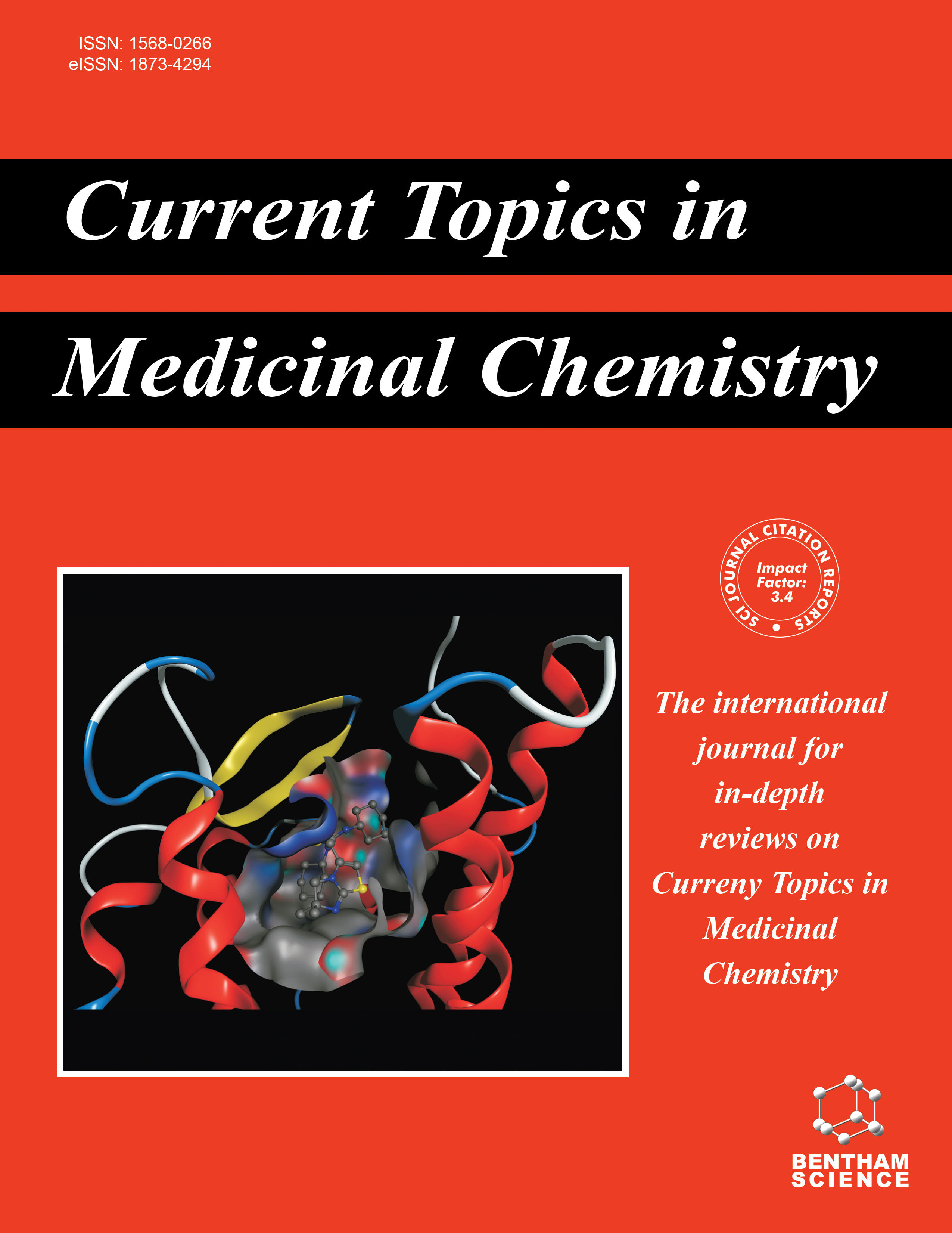- Home
- A-Z Publications
- Current Topics in Medicinal Chemistry
- Previous Issues
- Volume 13, Issue 16, 2013
Current Topics in Medicinal Chemistry - Volume 13, Issue 16, 2013
Volume 13, Issue 16, 2013
-
-
Role of Cations in the Interaction of Pradimicins with HIV-1 Envelope gp120
More LessAuthors: Bart Hoorelbeke, Youngju Kim, Toshikazu Oki, Yasuhiro Igarashi and Jan BalzariniPradimicins (PRM) are a unique class of nonpeptidic carbohydrate-binding agents that inhibit HIV infection by efficiently binding to the HIV-1 envelope gp120 glycans in the obligatory presence of Ca2+. Surface plasmon resonance (SPR) data revealed that addition of EDTA dose-dependently results in lower binding signals of PRM-A to immobilized gp120. Pradimicin derivatives that lack the free carboxylic acid gro Read More
-
-
-
Targeting Host Store-Operated Ca2+ Release to Attenuate Viral Infections
More LessAuthors: Kevin B. Clark and E. M. EisensteinViruses coopt host intracellular Ca2+ signaling pathways to optimize timing and effectiveness of infection stages against barriers to invasion, pathogenesis, replication, and release. Virus-induced changes in free cytosolic Ca2+ levels facilitate virus adsorption, uncoating, catalysis, toxin production, structural assembly and stabilization, trafficking, and fusion and budding. Ca2+-associated alterations in virus status also sel Read More
-
-
-
Retrospection on Polymorphism and Cocrystallization of Anti-Retrovirals
More LessAuthors: Renu Chadha, Madhu Bala, Dimpy Rani and Poonam AroraSuccessful pharmaceutical development of a drug molecule depends not only on its potency and selectivity but also on its solid state. Thus the properties of active pharmaceutical ingrdient depend on the identity of its constituents as well as on their arrangement. It is quite common for a drug molecule to exist in more than one crystalline arrangement leading to polymorphism. The various polymorphs differ from each oth Read More
-
-
-
Recent Developments in Azole Compounds as Antibacterial and Antifungal Agents
More LessAuthors: Xin-Mei Peng, Gui-Xin Cai and Cheng-He ZhouAzole compounds are an important class of nitrogen heterocycles with electron-rich property. This special structure endows azole-based derivatives easily bind with the enzymes and receptors in organisms through noncovalent interactions such as hydrogen bonds, coordination bonds, ion-dipole, cation-π,π-π stacking and hydrophobic effect as well as van der Waals force etc., thereby possessing various applications in medicinal ch Read More
-
-
-
Thiourea and Guanidine Derivatives as Antimalarial and Antimicrobial Agents§
More LessAuthors: Amita Mishra and Sanjay BatraThiourea and guanidine substructural units are of significant importance as the compounds containing these core units either in the open or the cyclic form are known to display an array of pharmacological properties. This brief review assimilates the literature on the medicinal significance of thiourea and guanidine derivatives with respect to antimalarial and antimicrobial activities.
-
-
-
Recent Advances in the Research and Development of Marine Antimicrobial Peptides
More LessAuthors: Mohammed I. El-Gamal, Mohammed S. Abdel-Maksoud and Chang-Hyun OhAntimicrobial peptides are a group of natural or semi-synthetic molecules possessing antimicrobial activities against bacteria, fungi, viruses, parasites, etc. They are considered as promising candidates for treatment of microbial infections and suppression of microbial resistance. The increasing emergence of bacterial resistance has required development of new efficient antibiotics that can be added to the antibacteri Read More
-
-
-
Synthesis, Antimicrobial, Anticancer Evaluation and QSAR Studies of Thiazolidin-4-Ones Clubbed with Quinazolinone
More LessA series of 3-(5-(arylidene)-2-(aryl)-4-oxothiazolidin-3-yl)-2-phenylquinazolin-4(3H)-one derivatives (1-18) was synthesized in appreciable yield and characterized by physicochemical and spectral means. The synthesized compounds were evaluated for their in vitro antimicrobial and anticancer potentials. Antimicrobial properties of the title compounds were investigated against Gram positive and Gram negative bacterial as well Read More
-
-
-
Synthesis and Characterization of 3β-Substituted Amides of 17a-Aza-Dhomo- 4-androsten-17-one as Potent 5α-Reductase Inhibitors and Antimicrobial Agents
More LessAuthors: Manav Malhotra, Rajiv Sharma, Ravindra K. Rawal, Hemraj Heer and T. R. BhardwajWe herein report the synthesis of 3β-substituted amides of 17a-aza-D-homo-4-androsten-17-one (11a-11r) from commercially available Diosgenin as the starting material. The structures of newly synthesized compounds were confirmed by IR, 1H NMR, 13C NMR and mass spectrometry. All the synthesized analogues were tested for their 5α- reductase inhibitory and antimicrobial activity, some of them exhibit moderate to poten Read More
-
-
-
Design, Synthesis and Antimicrobial Evaluation of Novel 1,3-Oxazolidin-2- one Derivatives
More LessA series of novel derivatives of 1,3-oxazolidin-2-one 12a-12n has been synthesized starting from 4-nitro-(L)- phenylalanine by involving five-step reaction sequence. All the compounds were screened for their in vitro antibacterial activity against four pathogenic bacterial strains namely, Staphylococcus aureus, Bacillus subtilis (Gram-positive), Escherichia coli, Pseudomonas aeruginosa (Gram-negative) and in vitro antifun Read More
-
-
-
Insight View on Possible Role of Fluoroquinolones in Cancer Therapy
More LessAuthors: Prabodh C. Sharma, Monika Chaudhary, Archana Sharma, Mona Piplani, Harish Rajak and Om PrakashCancer is a disease without limits turning out to be prime cause for raising death toll around the world. Several treatment strategies including chemotherapy, surgery and radiotherapy are being employed worldwide to combat this disease. Due to the unwanted effects of currently available therapies, scientific community is immensely interested in exploring newer alternative pathways. Fluoroquinolones have been employed Read More
-
Volumes & issues
-
Volume 25 (2025)
-
Volume 24 (2024)
-
Volume 23 (2023)
-
Volume 22 (2022)
-
Volume 21 (2021)
-
Volume 20 (2020)
-
Volume 19 (2019)
-
Volume 18 (2018)
-
Volume 17 (2017)
-
Volume 16 (2016)
-
Volume 15 (2015)
-
Volume 14 (2014)
-
Volume 13 (2013)
-
Volume 12 (2012)
-
Volume 11 (2011)
-
Volume 10 (2010)
-
Volume 9 (2009)
-
Volume 8 (2008)
-
Volume 7 (2007)
-
Volume 6 (2006)
-
Volume 5 (2005)
-
Volume 4 (2004)
-
Volume 3 (2003)
-
Volume 2 (2002)
-
Volume 1 (2001)
Most Read This Month
Article
content/journals/ctmc
Journal
10
5
false
en


